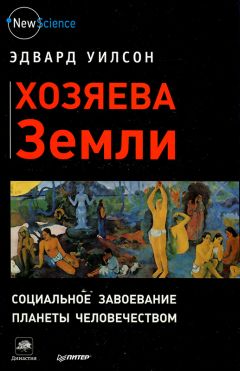Эдвард Уилсон - Хозяева Земли

Помощь проекту
Хозяева Земли читать книгу онлайн
Адаптивная эволюция в недавней эволюционной истории человека. Jun Gojobori et al., «Adaptive evolution in humans revealed by the negative correlation between the polymorphism and fixation phases of evolution» Proceedings of the National Academy of Sciences, U.S.A. 104(10): 3907–3912 (2007).
Изменения частоты мутантных генов. Jun Gojobori et al., «Adaptive evolution in humans revealed by the negative correlation between the polymorphism and fixation phases of evolution» Proceedings of the National Academy of Sciences, U.S.A. 104(10): 3907–3912 (2007).
Гены и эволюция когнитивной деятельности. Ralph Haygood et al., «Contrasts between adaptive coding and noncoding changes during human evolution» Proceedings of the National Academy of Sciences, U.S.A. 107(17): 7853–7857 (2010).
Наследуемость умственных признаков. B. Devlin, Michael Daniels, and Kathryn Roeder, «The heritability of IQ» Nature 388: 468–471 (1997). По разным оценкам, этот фактор варьирует от 0.4 до 0.7; скорее всего, он ближе к нижней границе.
Первый закон Туркхаймера. E. Turkheimer, «Three laws of behavior genetics and what they mean» Current Directions in Psychological Science 9(5): 160–164 (2000).
Генетические факторы и социальные сети. James Fowler, Christopher T. Dawes, and Nicholas A. Christakis, «Model of genetic variation in human social networks» Proceedings of the National Academy of Sciences, U.S.A. 106(6): 1720–1724 (2009).
Интеллектуальные концепции, появившиеся в неолите или раньше. Dwight Read and Sander van der Leeuw, «Biology is only part of the story» Philosophical Transactions of the Royal Society B 363:1959–1968 (2008).
Происхождение домашних растений. Colin E. Hughes et al., «Serendipitous backyard hybridization and the origin of crops» Proceedings of the National Academy of Sciences, U.S.A. 104(36): 14389-14394 (2007).
Естественный отбор у современных людей. Steve Olson, «Seeking the signs of selection» Science 298:1324–1325 (2002); Michael Balter, «Are humans still evolving?» Science 309: 234–237 (2005); Cynthia M. Beall et al., «Natural selection on EPAS1 (H1F20) associated with low hemoglobin concentration in Tibetan highlanders» Proceedings of the National Academy of Sciences, U.S.A. 107(25): 11459-11464 (2010); Oksana Hlodan, «Evolution in extreme environments» BioScience 60(6): 414–418 (2010).
11. Прыжок к цивилизации«Прыжок к цивилизации»: от племен к государствам. Kent V. Flannery, «The cultural evolution of civilizations» Annual Review of Ecology and Systematics 3:399–426 (1972); H. T. Wright, «Recent research on the origin of the state» Annual Review of Anthropology 6: 379–397 (1977); Charles S. Spencer, «Territorial expression and primary state formation» Proceedings of the National Academy of Sciences, U.S.A. 107:7119–7126 (2010).
Иерархический принцип Саймона. Herbert A. Simon, «The architecture of complexity» Proceedings of the American Philosophical Society 106:467–482 (1962).
Вариабельность личностных признаков в Буркина-Фасо. Richard W. Robins, «The nature of personality: genes, culture, and national character» Science 310: 62–63 (2005).
Внутрикультурная и межкультурная личностная изменчивость. A. Terraciano et al., «National character does not reflect mean personality trait levels in 49 cultures» Science 310: 96–100 (2005).
Время возникновения цивилизаций-государств. Charles S. Spencer, «Territorial expansion and primary state formation» Proceedings of the National Academy of Sciences, U.S.A. 107(16): 7119–7126 (2010).
Датировка возникновения первичных государств. Charles S. Spencer, «Territorial expansion and primary state formation» Proceedings of the National Academy of Sciences, U.S.A. 107(16): 7119–7126 (2010).
Быстрое возникновение первичного государства на Гавайских островах. Patrick V. Kirch and Warren D. Sharp, «Coral 230 Th dating of the imposition of a ritual control hierarchy in precontact Hawaii» Science 307:102–104 (2005).
Узоры на скорлупе страусиных яиц. Pierre-Jean Texier et al., «A Howiesons Poort tradition of engraving ostrich eggshell containers dated to 60,000 years ago at Diepkloof Rock Shelter, South Africa» Proceedings of the National Academy of Sciences, U.S.A 107(14): 6180–6185 (2010).
Древнейшее африканское искусство и оружие. Constance Holden, «Oldest beads suggest early symbolic behavior» Science 304: 369 (2004); Christopher Henshilwood et al., «Middle Stone Age shell beads from South Africa» Science 304: 404 (2004).
Древний храм в Гёбекли-Тепе. Andrew Curry, «Seeking the roots of ritual» Science 319: 278–280 (2008).
Происхождение письменности. Andrew Lawler, «Writing gets a rewrite» Science 292: 2418–2420 (2001); John Noble Wilford, «Stone said to contain earliest writing in Western Hemisphere» New York Times, A12 (15 September 2006).
Значение древних надписей. Barry B. Powell, Writing: Theory and History of the Technology of Civilization (Malden, MA: Wiley-Blackwell, 2009).
Культурная эволюция времен неолита и истоки разницы в уровне жизни. Jared Diamond, Guns, Germs, and Steel: The Fates of Human Societies (New York: W. W. Norton, 1997): русский перевод: Джаред Даймонд. «Ружья, микробы и сталь. Судьбы человеческих обществ.» ACT. Москва, 2012 г.; Douglas A. Hibbs Jr. and Ola Olsson, «Geography, biogeography, and why some countries are rich and others are poor» Proceedings of the National Academy of Sciences, U.S.A. 101(10): 3715–3720 (2004).
12. Появление эусоциальностиОбилие общественных насекомых в амазонском лесу. H. J. Fittkau and H. Klinge, «On biomass and trophic structure of the central Amazonian rainforest ecosystem» Biotropica 5: 2–14 (1973).
13. Причины успеха общественных насекомыхМуравьи-кочевники и их подопечные. U. Maschwitz, M. D. Dill, and J. Williams, «Herdsmen ants and their mealybug partners» Abhandlungen der Senckenbergischen Naturforschenden Gesellschaft Frankfurt am Main 557:1–373 (2002).
14. Научная загадка редкости общественного образа жизниЭволюционные истоки эусоциальности. Edward O. Wilson and Bert Hölldobler, «Eusociality: Origin and consequences» Proceedings of the National Academy of Sciences, U.S.A. 102(38): 13367-13371 (2005); Charles D. Michener, The Bees of the World (Baltimore: Johns Hopkins University Press, 2007); Bryan N. Danforth, «Evolution of sociality in a primitively eusocial lineage of bees» Proceedings of the National Academy of Sciences, U.S.A. 99(1): 286–290 (2002): Bert Hölldobler and Edward O. Wilson, The Superorganism: The Beauty, Elegance, and Strangeness of Insect Societies (New York: W. W. Norton, 2009).
Эусоциальность у раков-щелкунов.). Emmett Duffy, C. L. Morrison, and R. Ríos, «Multiple origins of eusociality among sponge-dwelling shrimps (Synalpheus)» Evolution 54(2): 503–516 (2000).
Уникальные эволюционные события. Geerat J. Vermeij, «Historical contingency and the purported uniqueness of evolutionary innovations» Proceedings of the National Academy of Sciences, U.S.A. 103(6): 1804–1809 (2006).
Помощники по уходу за птенцами. B. J. Hatchwell and J. Komdeur, «Ecological constraints, life history traits and the evolution of cooperative breeding» Animal Behaviour 59(6): 1079–1086 (2000).
15. Альтруизм и эусоциальность насекомых находит объяснениеПроисхождение обществ насекомых. William Morton Wheeler, Colony Founding among Ants, with an Account of Some Primitive Australian Species (Cambridge, MA: Harvard University Press, 1933); Charles D. Michener, «The evolution of social behavior in bees» Proceedings of the Tenth International Congress in Entomology, Montreal 2: 441–447 (1956); Howard E. Evans, «The evolution of social life in wasps» Proceedings of the Tenth International Congress in Entomology, Montreal, 2: 449–457 (1956).
Альтернатива теории родственного отбора. Martin A. Nowak, Corina E. Tarnita, and Edward O. Wilson, «The evolution of eusociality» Nature 466:1057–1062 (2010). Более свежая сводка содержится в работе: Martin A. Nowak and Roger Highfield in SuperCooperators: Altruism, Evolution, and Why We Need Each Other to Succeed (New York: Free Press, 2011).
Шаги на пути к эусоциальности у насекомых. Edward O. Wilson, «One giant leap: How insects achieved altruism and colonial life» BioScience 58:17–25 (2008).
Природные ресурсы и ранние этапы эусоциальности у насекомых. Edward O. Wilson and Bert Hölldobler, «Eusociality: Origin and consequences» Proceedings of the National Academy of Sciences, U.S.A. 102(38): 13367-13371 (2005).
Одиночные Hymenoptera. James T. Costa, The Other Insect Societies (Cambridge, MA: Belknap Press of Harvard University Press, 2006).
Эусоциальные жуки. D. S. Kent and). A. Simpson, «Eusociality in the beetle Austroplatypus incompertus (Coleoptera: Curculionidae)» Naturwissenschaften 79: B6–87 (1992).
Эусоциальные трипсы и тли. Bernard J. Crespi, «Eusociality in Australian gall thrips» Nature 359:724–726 (1992); David L. Stern and W. A. Foster, «The evolution of soldiers in aphids» Biological Reviews of the Cambridge Philosophical Society 71: 27–79 (1996).
Эусоциальные раки-щелкуны. J. Emmett Duffy, «Ecology and evolution of eusociality in sponge-dwelling shrimp» in J. Emmett Duffy and Martin Thiel, eds.. Evolutionary Ecology of Social and Sexual Systems: Crustaceans as Model Organisms (New York: Oxford University Press, 2007).
Общественные колонии пчел, полученные в экспериментальных условиях. Shoichi F. Sakagami and Yasuo Maeta, «Sociality, induced and/or natural, in the basically solitary small carpenter bees (Ceratina)» в книге Yosiaki Itô, Jerram L. Brown, and Jiro Kikkawa, eds., Animal Societies: Theories and Facts (Tokyo: Japan Scientific Societies Press, 1987), pp. 1–16; William T. Wcislo, «Social Interactions and behavioral context in a largely solitary bee, Lasioglossum (Dialictus) figueresi (Hymenoptera, Halictidae)» Insectes Sociaux 44:199–208 (1997); Raphael Jeanson, Penny F. Kukuk, and Jennifer H. Fewell, «Emergence of division of labour in halictine bees: Contributions of social interactions and behavioural variance» Animal Behaviour 70:1183–1193 (2005).
Модель фиксированного порога при разделении труда у насекомых. Gene E. Robinson and Robert E. Page Jr., «Genetic basis for division of labor in an insect society» in Michael D. Breed and Robert E. Page Jr., eds., The Genetics of Social Evolution (Boulder, CO: Westview Press 1989), pp. 61–80; E. Bonabeau, G. Theraulaz, and Jean-Luc Deneubourg, «Quantitative study of the fixed threshold model for the regulation of division of labour in insect societies» Proceedings of the Royal Society B 263:1565–1569 (1996); Samuel N. Beshers and Jennifer H. Fewell, «Models of division of labor in social insects» Annual Review of Entomology 46:413–440 (2001).
16. Гигантский скачок для всех насекомыхЦенность защиты гнезда. J. Field and S. Brace, «Pre-social benefits of extended parental care» Nature 427: 650–652 (2004).
Возникновение и исчезновение эусоциальности в эволюции пчел. Bryan N. Danforth, «Evolution of sociality in a primitively eusocial lineage of bees» Proceedings of the National Academy of Sciences, U.S.A. 99 (1): 286–290 (2002).
Сезонные изменения способствуют общественному поведению. James H. Hunt and Gro V. Amdam, «Bivoltinism as an antecedent to eusociality in the paper wasp genus Polistes» Science 308: 264–267 (2005).

























